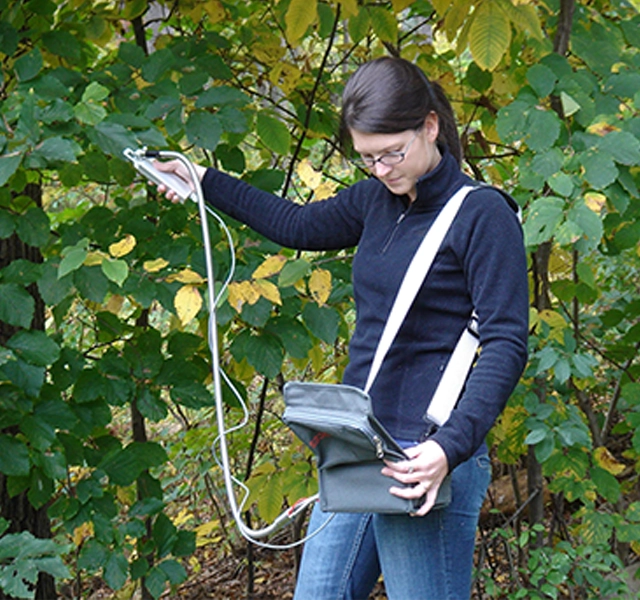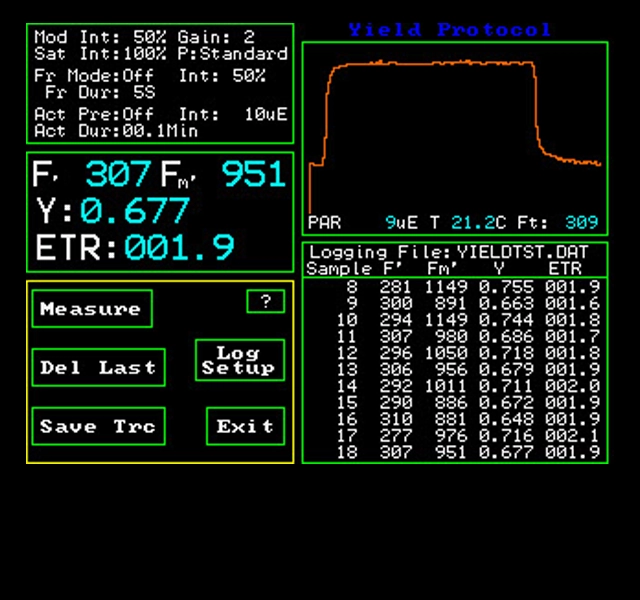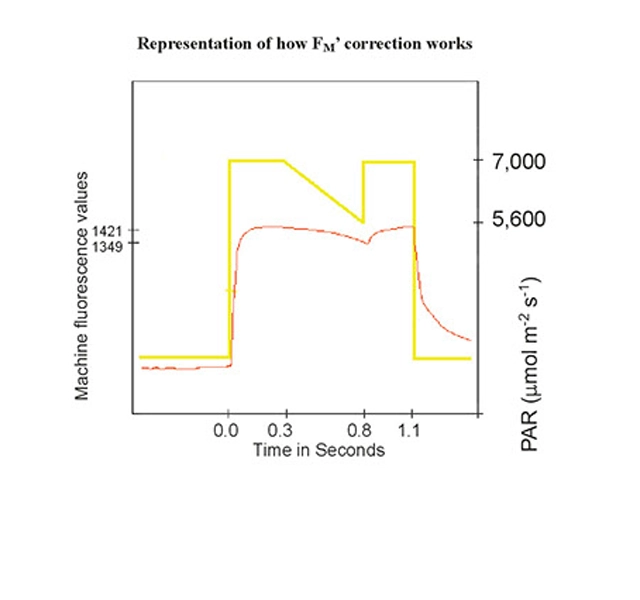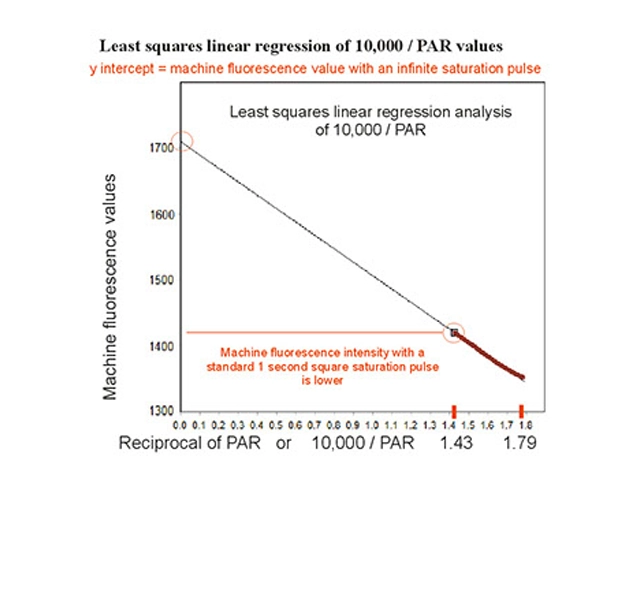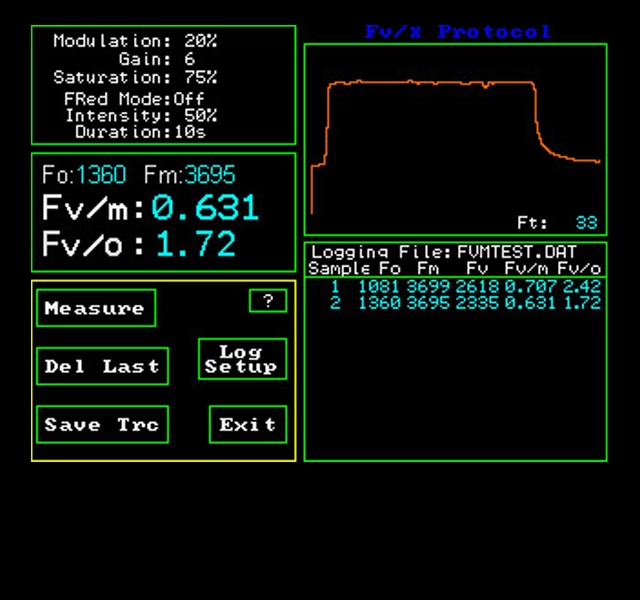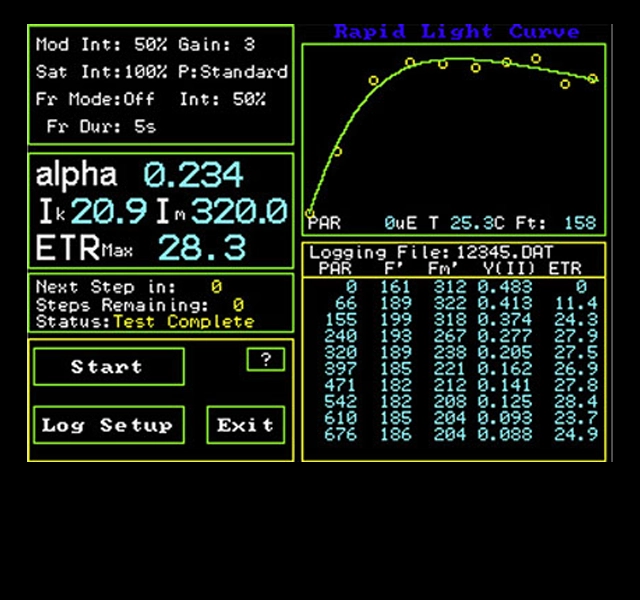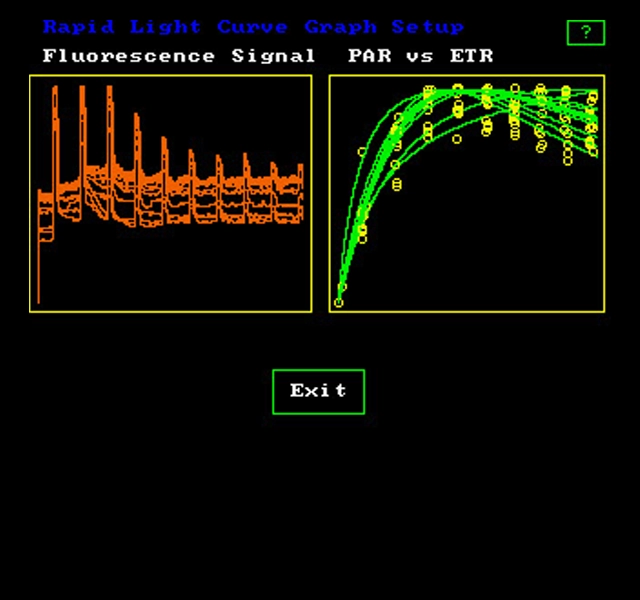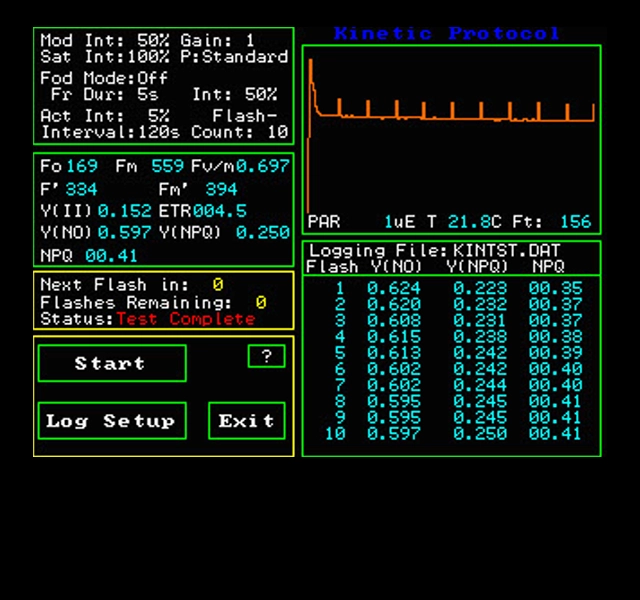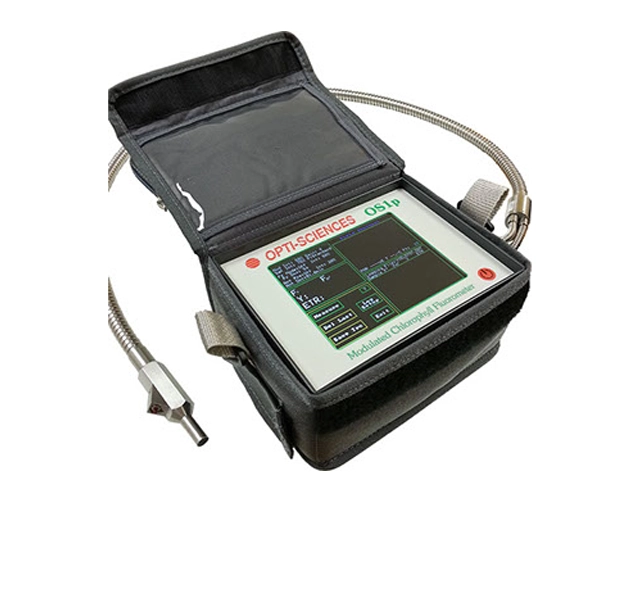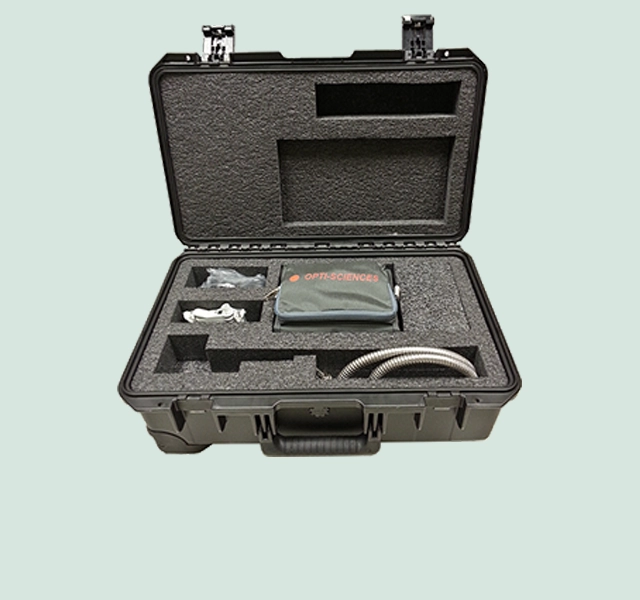OS1p
Chlorophyll Fluorometer
Best in class – measures Y(II), ETR, Leaf temp, FV/FM, quenching, & has FM‘ correction option included.
This instrument provides many plant stress measuring protocols, at a low price. OS1p capability includes the fast measurements: Y(II) or ΔF/FM‘, ETR, leaf temperature, and FV/FM. It also provides the Hendrickson lake model quenching protocol to allow NPQ, Y(NPQ), and Y(NO) measurements. Rapid light curves are also included.
The OS1p is designed to provide a cost effective, yet comprehensive plant stress measuring chlorophyll fluorometer. It is optimally designed to measure the light adapted protocol developed by Bernard Genty, ΔFM/FM‘ or Y(II), the Burke water stress assay, and the dark adapted protocols: FV/FM, Rapid Light Curves (for changing light conditions found under canopy and in aquatic measurements), and basic quenching measurement using the lake model Hendrickson protocol with NPQ, Y(NPQ) and Y(NO).
- Stable Internal Actinic Light Source for reliable field and laboratory quenching tests
- Loriaux (2013) FM‘ Correction Option or Square Topped Saturation Flash
- Optional PAR clip – Measures PAR , leaf temperature and can be used for ETR measurements
- Integrated GPS/GLONASS location receiver
- 6 – 8 hour battery charge life
- Automated modulated light set-up
- Menu driven color graphic touch screen interface.
- USB and removable SD memory card.
- Data is stored in comma delimited files
- Armored fiber optic light guide
Y(II): Quantum Photosynthetic Yield of PSII (also called ΔF/FM’).
ETR: Electron transport rate (with optional PAR clip).
PAR: Photosynthetically Active Region value (with optional PAR clip).
T: Leaf temperature (with optional PAR clip).
FV/FM: Maximum Photochemical efficiency of PSII.
FV/FO: A more sensitive detector of stress than FV/FM, but it does not correlate with gas exchange.
FO: Minimum chlorophyll fluorescence.
FM: Maximal chlorophyll fluorescence.
FV: Variable fluorescence.
FM’: Maximum fluorescence using a saturation flash (also called FMS).
FS: Fluorescence under steady state actinic conditions prior to saturation pulse (also called F’).
RLC (Rapid light curves):
rETRMAX:A measure of a leaf’s photosynthetic MAX capacity or maximum electron transport rate under variable light conditions. α is the initial slope of line at low PAR values created by relating ETR to PAR. It provides a measure of quantum efficiency.
Ik=rETRMAX/α:A measurement of the light intensity where light saturation starts to dominate, or the minimum saturation level.
Im:the light intensity at ETRMAX.
Quenching protocol:
Hendrickson lake model quenching protocol:
Y(NPQ), Y(NO), Y(II), NPQ, FV/FM.
Kramer Quenching (standard):
qL, Y(NPQ), Y(NO), Y(II), FV/FM.
Puddle model parameters (standard):
NPQ, qN, qP, Y(II), FV/FM.
Quenching relaxation protocol (standard):
qE, qM, qZ, qT, qI along with either puddle model, or Hendrickson parameters. Adjustable times for each.
GPS location.
Parameters Measured and Protocols included:
Y(II):
Quantum Photosynthetic Yield of PSII (or ΔF/FM‘ or Y(II)).
ETR:
Electron transport rate (w/optional clip).
PAR:
Photosynthetically Active Region value (with optional PAR clip).
T:
Leaf temperature (with optional PAR clip).
FV/FM:
Maximum Photochemical efficiency of PSII.
FV/FO:
A more sensitive detector of stress than FV/FM, but it does not measure plant efficiency.
FO:
Minimum fluorescence.
FM:
Maximal fluorescence.
FV:
Variable fluorescence.
FMS (or FM‘):
Maximal fluorescence with actinic illumination.
FS (or F):
Fluorescence under steady state conditions (prior to saturation pulse).
Multi-Flash with FM‘ correction and ETR correction.
RLC (Rapid light curves):
rETRMAX:
A measure of a leaf’s photosynthetic MAX capacity or maximum electron transport rate α is the initial slope of line at low PAR values created by relating ETR to PAR. It provides a measure of quantum efficiency.
Ik=rETRMAX/α:
A measurement of the light intensity where light saturation dominates, or the minimum saturation level.
I:
PAR light intensity at ETRMAX.
Quenching protocol:
Hendrickson lake model quenching protocol:
Y(NPQ), Y(NO), Y(II), NPQ, FV/FM.
Kramer Quenching (standard):
qL, Y(NPQ), Y(NO), Y(II), FV/FM.
Puddle model parameters (standard):
NPQ, qN, qP, Y(II), FV/FM.
Quenching relaxation protocol (standard):
qE, qM, qZ, qT, qI along with either puddle model, or Hendrickson parameters. Adjustable times for each.
Optional PAR Clip
Measures PAR and leaf temperature. It should be purchased for Y(II) and ETR measurements. The PAR Clip is also recommended for rapid light curves and quenching measurements because it allows the built-in actinic light source to remain at a stable light intensity during longer measurements.
Light Sources:
Saturation pulse:
White LED with 690nm short pass filter. 15,000 μmols.
Modulated light:
660nm LED with 690nm short pass filter.
Actinic light source:
White LED to 3,000 μmols.
Far red light:
720nm LED with > 700nm long pass filter.
Detection method:
Pulse modulation method.
Detector & Filters:
A PIN photodiode with a 700nm ~ 750nm bandpass filter.
Sampling Rate:
Auto-switching from 10 to 10,000 points per second, depending on phase of test.
Automated routine to optimally set the modulated light intensity.
The modulated light may also be set manually.
Multi-Flash FM‘ correction for all light adapted protocols.
It may be turned on or off.
Operational:
Test Duration:
Adjustable from 0.1 seconds to 12 hours.
GPS location:
Built in GPS / GLONASS 12 channel receiver with internal antenna.
Storage Capacity:
1 Gigabyte of non-volitile flash memory.
Digital Output:
USB removable storage device standard. Comma delimited files.
SD/MMC data card.
User Interface:
640 x 480 graphic color touch screen.
Menu driven software.
Power Supply:
Internal 12V, rechargeable nickel metal hydride battery.
Battery Life:
6 to 8 hours of continuous operation.
Dimensions:
7 in x 5.5 in x 3.25 in (17.8 cm, x 14 cm, 8.3 cm).
Weight:
3.6 lbs (1.62 kg)
Specifications subject to change without notice.
Accessories

FL-ARM
Adjustable locking desktop arm
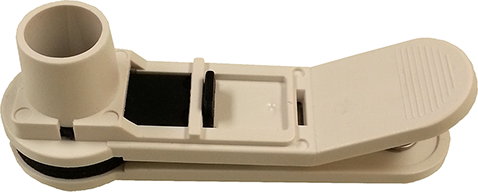
FL-DC
Dark adaptation clip
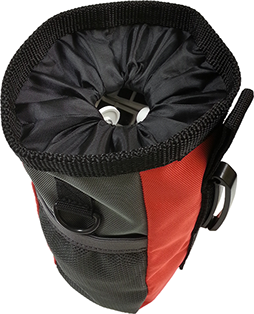
FL-DC50
Pouch of 50 clips
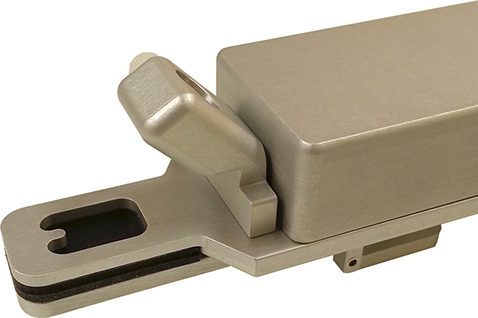
FL-PAR
PAR clip
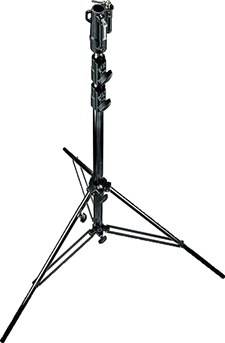
FL-T
Large universal tripod – extends from 1.4m to 3.2m
